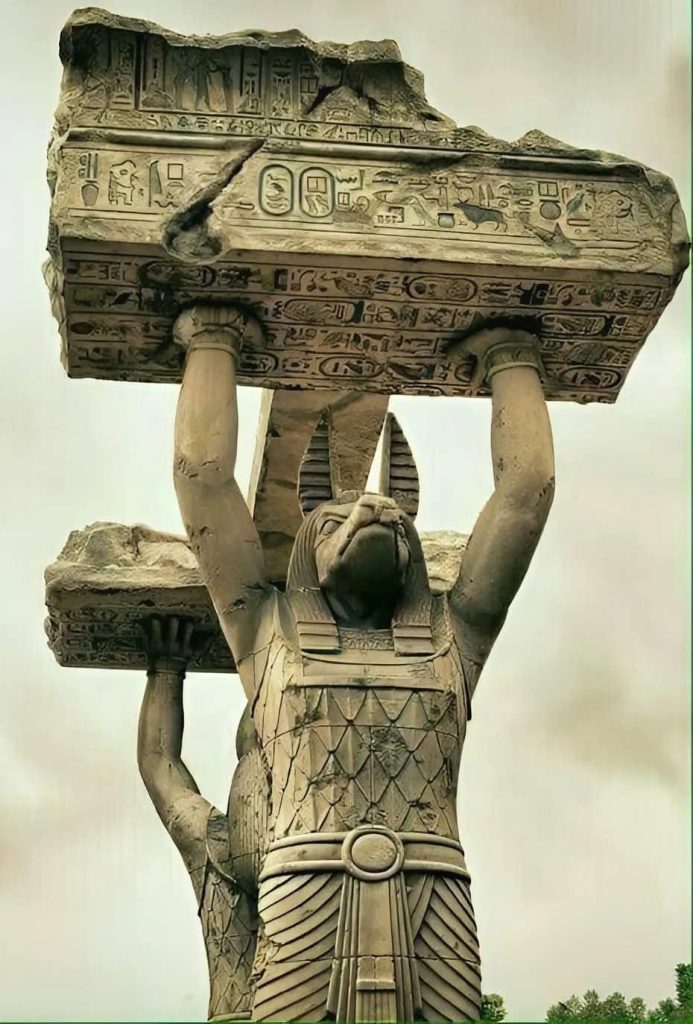In the mystical realm of ancient Egypt, where myth and reality seamlessly blended into the fabric of daily life, stood two monumental statues that transcended their stone origins to embody something far greater. These were not ordinary sculptures, nor were they mere artistic tributes to a bygone era. They were powerful emblems of divine authority, protectors of sacred wisdom, and sentinels of a civilization that understood the delicate balance between the mortal world and the divine. Their presence continues to command awe and reverence, standing as a testament to a society that saw no boundary between the spiritual and the earthly.

Known as the Divine Sentinels, these jackal-headed figures evoke the powerful image of Anubis—the ancient Egyptian god of the afterlife, embalming, and protection. Revered for his role as a guide of souls through the underworld, Anubis was a figure of immense spiritual importance, and these statues, with their muscular forms and commanding posture, reflect that same authority and purpose. Positioned as eternal guardians, they watched over the temples, tombs, and sacred spaces of Egypt, ensuring that the divine order—known as Ma’at—was maintained. Their jackal features, both fierce and noble, symbolize vigilance, strength, and the sacred duty of protection.
What sets these statues apart is not just their size or imposing design, but the profound responsibility they seem to bear. Each figure supports an immense stone slab on its shoulders, a burden not just of weight, but of meaning. These slabs are intricately inscribed with hieroglyphics—the sacred script of ancient Egypt, used to preserve the wisdom of the gods, kings, and scholars. These hieroglyphs are more than mere decoration; they are the lifeblood of Egyptian knowledge and belief, carrying prayers, spells, and records meant to endure for eternity. In this way, the statues serve as silent custodians of ancient truth, bearing the immense burden of safeguarding knowledge across the ages.
Despite standing firm against the passage of time, these divine protectors are not untouched by it. The centuries have left their marks—fine cracks stretch across their weathered surfaces, and erosion has softened once-sharp lines. Yet these marks do not diminish their grandeur. On the contrary, they amplify it. Like scars on a warrior, these signs of age are symbols of endurance, proof that even in the face of time’s relentless march, divine purpose remains unshaken. Their very survival through the rise and fall of dynasties, invasions, and natural decay speaks to their enduring significance and the reverence with which they have been regarded.
Beyond their physical presence, these statues hold immense spiritual value. In the eyes of the ancient Egyptians, they were more than stone—they were animate vessels of divine will. As embodiments of Anubis’s protective power, they served as a bridge between the realms of the living and the dead, offering guidance and safeguarding the transition of the soul. Their role extended beyond the afterlife; they protected sacred spaces from desecration, ensuring that rituals were conducted properly and that the sanctity of knowledge was preserved. In this way, they played a crucial role in the spiritual life of ancient Egypt, embodying the principle that knowledge and faith were intertwined and both worthy of divine guardianship.
The craftsmanship evident in these statues is nothing short of extraordinary. Ancient Egyptian artisans were renowned for their skill, and these figures represent some of their finest work. Every muscle carved into the stone, every curve of the jackal’s head, every hieroglyph painstakingly etched onto the stone slabs—each detail reflects a society that valued precision, artistry, and meaning. These statues were not created merely to impress; they were meant to inspire reverence, to embody ideals, and to stand the test of time both physically and symbolically. In their form, we see the union of spiritual devotion and artistic mastery—a hallmark of ancient Egyptian culture.
Even today, millennia after their creation, these jackal-headed guardians continue to stir the imagination of all who encounter them. Their presence evokes a sense of awe and curiosity, drawing modern observers into the mysteries of an ancient world that still holds countless secrets. They are living symbols of humanity’s enduring quest to understand the universe, to seek protection for what is sacred, and to preserve knowledge for future generations. In their stoic, dignified posture, they remind us that some truths transcend time—that the need to protect wisdom, honor the divine, and safeguard the spiritual legacy of a people is as relevant now as it was thousands of years ago.
Through countless generations, these sentinels have witnessed the evolution of civilizations, the shift of cultural tides, and the relentless advance of history. And yet, they remain, silent but ever-watchful, guarding the treasures of a world long gone but never forgotten. Their legacy is one of resilience, strength, and unwavering purpose—a legacy that continues to inspire and captivate, reminding us that the ancient Egyptians, in their devotion to the divine and commitment to preserving wisdom, achieved a kind of immortality through stone and spirit alike.





